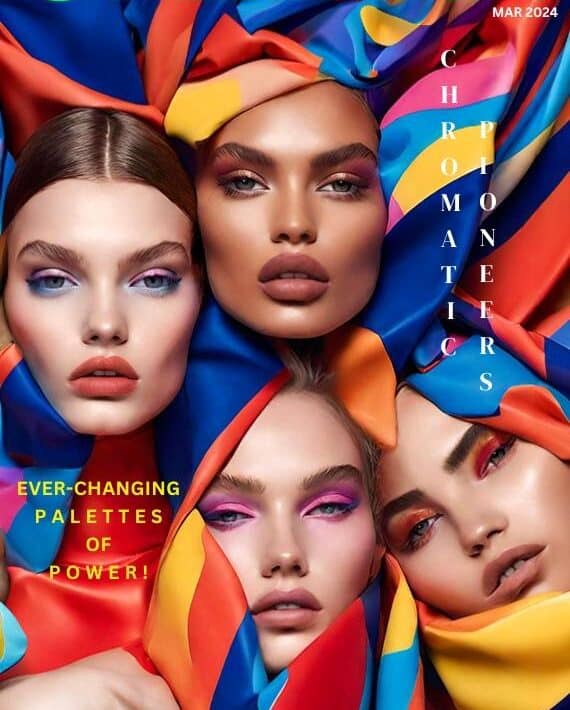Electric Forms: When Art Learned to Pulse

They say fashion tells a story, but for Dina Yassin,…
There was a time when art sat quietly. Dignified in white-walled galleries. Smoothed into polished design showrooms. Labeled, contained, explained. It was the kind of world where you admired from a distance, hands behind your back, murmuring observations like, “How fascinating.”
But that world is gone.
Now, art flinches. Design glows. Architecture shifts. We’re no longer just creating form—we’re waking it up. Art no longer wants to be admired. It wants to be felt. To provoke, to react, to glitch and flicker in real time.
And if you’ve been paying attention, you’ll know the revolution isn’t coming—it’s already here. It’s tangled in the LED veins of Seoul’s digital pavilions, baked into the sun-soaked adobe walls of Mexico City’s tech-art collectives, and humming beneath the recycled floors of Milan’s haunting design venues.
Let’s start there—Milan.
At this year’s Milan Design Week, it wasn’t just a show of objects. It was an exhale of energy. At Alcova, a reimagined former military hospital on the outskirts of the city, designers weren’t unveiling lamps or chairs. They were unveiling reactions. Recycled glass installations pulsed under UV light. Walls dripped with algae. One structure made entirely of bio-leather released the faint, damp smell of soil—earthy and unnerving. “We’re not designing objects anymore,” said a Berlin artist in dusty boots. “We’re designing living systems.”
In that space, design wasn’t decoration—it was declaration.
And the shockwave isn’t confined to Europe. In Tokyo, teamLab has been breaking boundaries with art that responds to viewers in real-time—blurring the line between museum and organism. Elsewhere in the city, anonymous collectives transformed convenience stores into dystopian sculptures: algorithmic shelves blinking back, vending machines dispensing “emotionally aligned snacks.” It wasn’t parody. It was precision.
Meanwhile in Mexico City, the shape of architecture is mutating. Pop-up pavilions rise like origami, holding VR headsets that transport you through centuries of Indigenous storytelling. Projections—responsive to your movements—spill across adobe walls, flickering between digital myth and living memory. There’s no border here between tradition and tech. It folds. It overlaps. It insists.
And then there’s Lagos—brutal, brilliant, and deeply unbothered. There, you don’t see “emerging trends.” You see urgency. Artists are building futures from fragments: salvaged screens, broken mirrors, reprogrammed soundboards. “This isn’t post-colonial design,” a young Nigerian creator told me, adjusting a headset he soldered himself. “This is pre-everything else. We’re not referencing the past. We’re rewriting what comes next.”
Even the old guard is glitching.
In Paris, AI art collectives are quietly reprogramming Renaissance busts—sculptures whose expressions shift based on real-time sentiment data scraped from social media. One statue’s lips curl into a near-smirk as war trends on Twitter. Another softens as joy filters through the algorithm. No one knows what to feel. And that’s the point. These aren’t static tributes. They’re feedback loops.
What we’re seeing—everywhere—is a complete detachment from permanence.
Designers today aren’t interested in objects that last forever. They’re interested in moments that live now. In movement. In sensation. In coding identity through motion and light. Artists have become cultural software developers. Thinkers in neon. Dancers with soldering irons. They’re remixing memory, glitching emotion, and looping our attention spans into something worth pausing for.
This isn’t the cold futurism of the early 2000s. This is something hotter, messier. Electric, yes—but also deeply human. It sweats. It groans. It crashes. It dreams.
And it asks more from us, too. Not just to consume—but to participate. To engage with art that’s breathing back at you. To walk through spaces that won’t let you remain neutral.
Because in this world, materials are no longer neutral. Clay, pixels, light, language—they’re all in conversation. Nothing is just what it is anymore. Everything pulses with possibility.
So maybe the question isn’t what is art becoming? Maybe the better question is: What are we becoming, now that art refuses to sit still?
One thing’s certain: it’s not a trend. It’s a current. And it’s alive.
So plug in. Or step aside.
What's Your Reaction?
They say fashion tells a story, but for Dina Yassin, it’s more than just storytelling—it’s an art, a science, and a little bit of magic. As the Co-Founder, Chief Storyteller, and Editor-in-Chief of GAZETTA—among many other titles—she’s the woman behind the words, the visionary shaping narratives, and the creative force redefining luxury fashion journalism in the digital age. With over two decades of experience in luxury brand consulting, creative direction, and trend forecasting, Dina has worked with some of the most coveted names in the industry—think Van Cleef & Arpels, Kenzo, Bvlgari, Hermès, and Chloe—all while keeping her finger firmly on the pulse of what’s next. Her work has graced the pages of Vogue Arabia, Harper’s Bazaar, Condé Nast Traveler, Mojeh Magazine, Vanity Fair, Marie Claire, 7 Corriere, and The Rake—among many other top-tier titles—solidifying her reputation as a fashion and luxury thought leader. But here’s the twist—Dina isn’t just reporting on the future; she’s creating it. Under her leadership, GAZETTA introduced EVVIE 7, an AI-driven journalist pushing the boundaries of editorial innovation. Because in a world where algorithms influence aesthetics as much as designers, Dina ensures GAZETTA stays one step ahead, seamlessly blending technology, culture, and high fashion into a platform that speaks to the modern, forward-thinking luxury consumer. Beyond her editorial expertise, Dina is a renowned luxury brand consultant, trend strategist, and creative powerhouse who thrives at the intersection of fashion, culture, and digital storytelling. Whether she’s consulting on luxury branding, forecasting emerging trends, directing high-profile fashion campaigns, or curating immersive experiences, she’s always asking the big questions—What’s next? Who’s shaping it? And most importantly, how do we make it unforgettable? One thing is certain: Dina Yassin is always at the forefront of what’s next.



